Speech Reconnecting Corporate Australia with Frozen Credit Markets

John Broadbent
Head of Domestic Markets Department
Address to Corporate Finance World Australia 2009
Sydney –
- Audio 8.85MB
- PDF version 75KB
Introduction
Corporate balance sheets have undergone quite a transformation over the past few years. Equity raisings have increased, debt outstanding has declined and cash balances are at record highs. Earlier this decade, corporate balance sheets with relatively conservative gearing ratios were described as ‘lazy’, with boards encouraged to take on additional debt to generate higher returns for shareholders. Those balance sheets would now be considered as ‘de rigueur’. A Modigliani-Miller disciple, however, would recognise that a company's value should be invariant to its capital structure and that while higher gearing may imply higher shareholder returns, they come as the counterpart to higher risks taken by those shareholders.
This morning I would like to examine some of the recent changes that have occurred on corporate balance sheets since the onset of the international financial crisis. My presentation is somewhat less grandiose than the title in the programme, though nevertheless, a theme is that the reduction in corporate leverage that we have seen reflects both a decline in demand for credit from businesses, and some tightening in the terms and conditions under which credit is being extended.
Corporate Balance Sheets[1]
Companies obtain funds from a number of sources. Funds can be generated internally from profitable operations by retaining earnings, or they can be raised externally by borrowings from banks, issuing securities into debt and money markets or raising equity. During the international financial crisis, this mix of internal and external funding has changed significantly as corporates have responded to evolving economic and financial market conditions.
Prior to the onset of the turbulence in financial markets in mid 2007, about two-thirds of all corporates' funding was derived internally – that is, cash profits from normal trading operations – with the remainder coming from external sources. The split appears typical for companies in other advanced economies.
Leaving aside the financial sector, which obviously has a very different balance sheet structure, it is most helpful to classify corporates into three broad categories: resources, real estate and infrastructure, and the remainder (which include companies in the retail, manufacturing, telecommunications, information technology and healthcare sectors). Each sector makes up about 30 per cent, 10 per cent and 25 per cent of the ASX market capitalisation respectively.
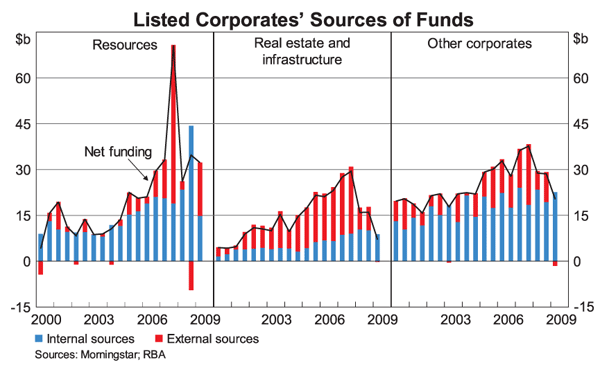
Over the past decade, resource companies have not relied much on external funding as their strong profit growth has provided most of the cashflow needed to finance investments (Graph 1). Only around 10 per cent of resource companies' funding has been sourced externally. (The spike in the second half of 2007 reflects Rio Tinto's debt-funded purchase of Alcan. Two years later, Rio Tinto undertook a large equity raising to repay this debt.) In contrast, around 60 per cent of funding for real estate and infrastructure companies came from external sources, reflecting their tendency to fund expansion through debt prior to the crisis. As with many investors globally, these companies responded to the favourable macroeconomic and financial conditions by increasing borrowings against existing assets, a practice supported by rising asset values. For these companies, gearing ratios increased from around 55 per cent at the start of the decade to around 100 per cent by mid 2007. For the remainder of the corporate sector, internal funding sources remained fairly steady, averaging about 70 per cent.
This mix changed substantially with the onset of the financial turmoil. Almost all corporates relied more heavily on internal funding as relative borrowing costs for debt rose, and debt funding became more difficult to access, particularly for lower-rated corporates. Companies sought to actively wind back their leverage. This was possible because listed corporates' internal funding has proved to be fairly resilient despite the slowdown in economic activity and the deterioration in financial conditions. Cash profits for the corporate sector have been fairly steady at around $100 billion annually since mid 2007. Resource companies' profits have been underpinned by high average commodity prices. Real estate profits have held up due to strong rental income owing to high rents and low office vacancy rates, while infrastructure and other companies' profit performances have been consistent with the comparative resilience of the Australian economy.
With net debt funding declining sharply, and corporates continuing to raise significant amounts of equity, the composition of external funding has shifted away from debt toward equity. Listed corporates have raised a record amount of equity this year, totalling some $60 billion, with issues broadly based across all sectors (Graph 2). This compares with an annual average of around $20 billion in the three years prior to the financial crisis. Buybacks by already-listed companies remain subdued, with corporates preferring to retire debt or retain cash.
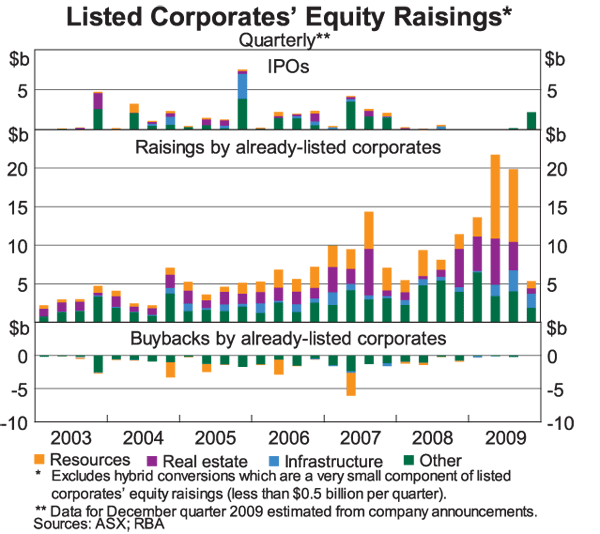
As noted, many of these equity raisings have been used to pay down debt. Indeed, it has been fairly common for companies' announcements to explicitly state that equity raisings are being used to repay bank loans. These substitutions have contributed to the decline in business credit over 2009.
Some companies, particularly in the real estate and infrastructure sectors, have needed to raise more equity capital as a condition for the continued availability of loan finance. In those cases, the tightening in lending standards has been a significant constraint on their operations. In aggregate, however, firms appear able to refinance as needed, albeit on tighter terms and conditions (Graph 3). For most companies, it would seem that the highly uncertain economic outlook has reduced the demand for credit. They have been looking to pay back loans and have wanted to reduce gearing, despite the fact that debt finance is now cheaper.
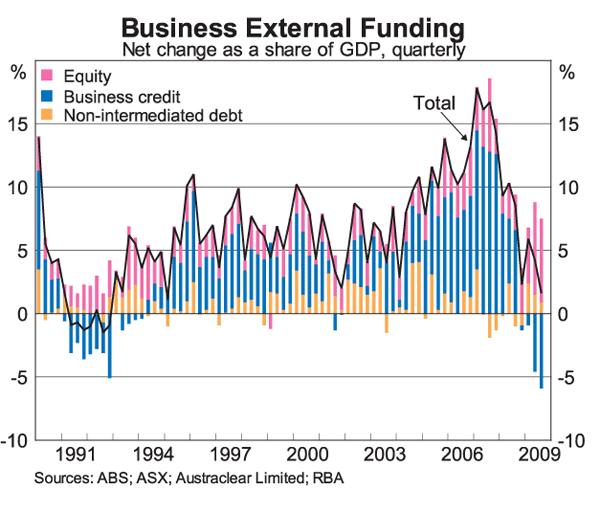
The reduction of leverage by corporates has seen gearing decline by around 20 percentage points over the course of 2009 to around 65 per cent, close to its historical average (Graph 4). In aggregate, the fall during the latest episode has been much smaller compared with the early 1990s when gearing more than halved, having peaked at over 100 per cent in the late 1980s (though the run-up in gearing was also less).
By sector, the reduction in gearing has been broad based. Real estate and infrastructure companies have raised over $20 billion of equity so far this year – which represents about 20 per cent of their market capitalisation – but large asset writedowns over the same period has meant that their gearing ratio is still elevated compared to history. Their gearing has fallen to around 105 per cent, a higher level than prior to the onset of the financial turmoil. Some of these companies are continuing to restructure their balance sheets. In contrast, gearing of other non-resource corporates has been falling over the past few years to be around the lower level of its historical range. Resource companies' gearing has fallen by around 20 percentage points to around 40 per cent. The bulk of this reflects the unwinding of Rio Tinto's prior increase in leverage from its takeover of Alcan, though relatively high levels of retained earnings in the resources sector have also contributed to this reduction.
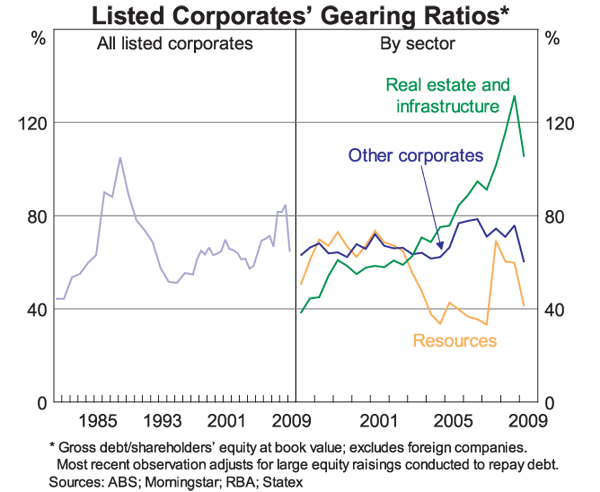
Over the past two years, there has also been a change in the composition of debt funding. While intermediated borrowing has declined this year, this has been partly offset by corporates tapping the bond market as financial strains have eased throughout 2009 (Graph 5). This is a relatively recent development, however.
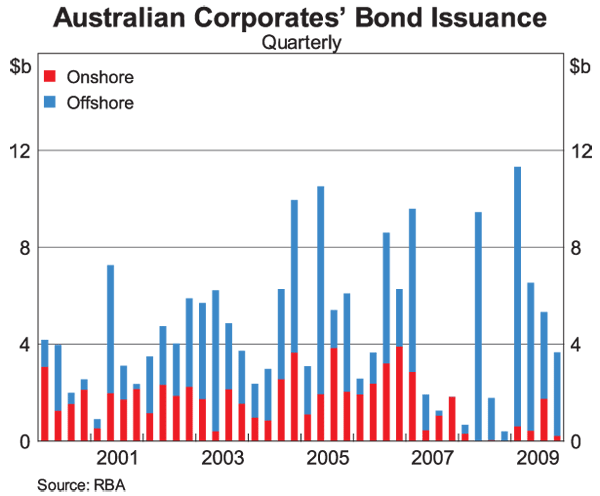
In the early part of the financial turmoil, corporates drew upon their credit facilities from banks as capital markets dried up, pushing up business credit growth in excess of 25 per cent. Firms reduced long-term borrowings from capital markets as rising risk aversion and uncertainty pushed up borrowing costs. Bond issuance slowed sharply to average just over $1 billion per quarter over the latter half of 2007 and early 2008, compared with over $5 billion in previous years. For the typical investment grade corporate (rated BBB), yields jumped from just 80 basis points above a comparable bond issued by the Australian Government (CGS), to over 9 per cent, or over 200 basis points above CGS by the middle of 2008 (Graph 6). The very limited investor appetite meant that issuance was restricted to larger corporates with an established presence in capital markets.
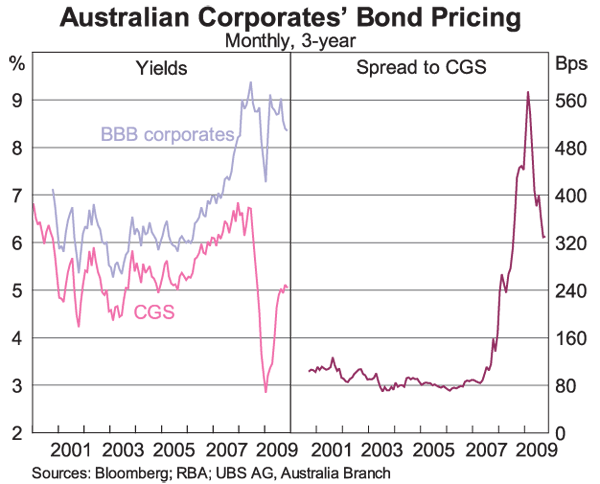
As risk aversion reached extreme levels following the failure of Lehman Brothers, the appetite for corporate paper evaporated and issuance ceased. The spread to CGS rose to more than 5½ percentage points. We would need to go back to the early 1930s to see spreads at such levels (assuming that spreads in Australia and the US would have been similar at that time), although in absolute terms, yields were not high in an historical sense.
As markets have thawed as investor demand for investment grade paper has returned, gross issuance has resumed, though spreads remain well above the levels seen prior to the financial turmoil. Corporate bonds outstanding have risen by over 10 per cent since mid 2007 to total $150 billion. These raisings of non-intermediated debt have provided a significant fillip to businesses external funding, despite the turndown in intermediated lending in 2009. This is in contrast to the episode in the early 1990s when the reduction in intermediated finance was not fully offset by either a pick up in equity raisings or increased borrowings in the capital markets.
Smaller companies and unincorporated enterprises do not, of course, have the same access to these alternative sources of finance (Graph 7). However, bank credit has continued to flow to this sector, with the fall-off in total business credit since the end of last year being mainly associated with lending to larger businesses. Outstandings to smaller entities have risen at an annualised rate of around 5 per cent over the past six months, and is about 10 per cent higher than its level in mid 2007, prior to the onset of the financial crisis.
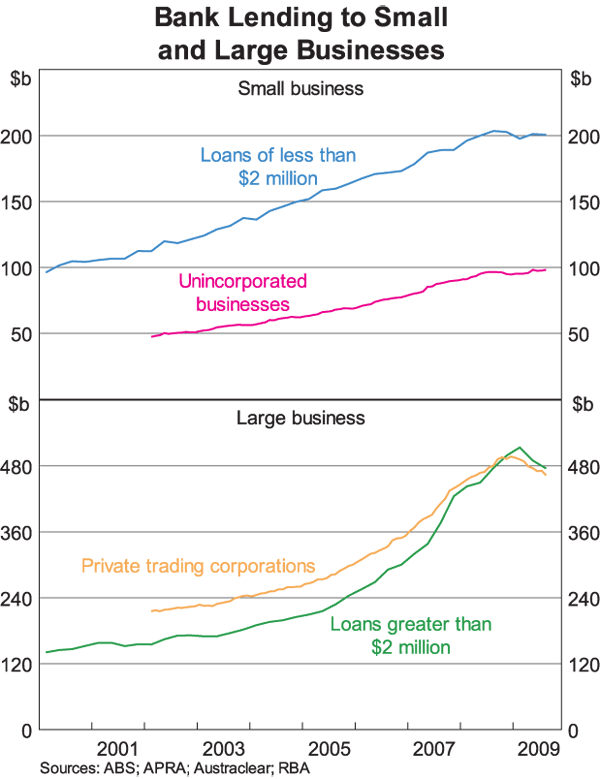
While business credit has turned down across all types of banks, the falls have been smallest for the major banks and a little larger than average for the foreign-owned banks (Graph 8). The difference in growth rates partly reflects the activities in which the foreign banks specialised, that is, lending predominantly to the larger corporates.
As was the pattern worldwide, mergers and acquisitions (M&A) activity had been rising throughout the decade, with most of the finance for these transactions being provided by the banking sector – so called leveraged loans for leveraged buyouts. As noted earlier, by mid 2007, business credit offered by banks was growing at an annualised rate in excess of 25 per cent, with credit provided by the foreign banks increasing by about 40 per cent. Some rough figuring by the Bank suggests that over half of the funding for leveraged buyouts in Australia in the previous five years was sourced from debt provided by the foreign-owned banks. This was an area of business where the major Australian banks also participated, albeit as much smaller players. Their share probably accounted for just one-eighth of leveraged buyout funding, with the remainder being provided by some form of equity injection.
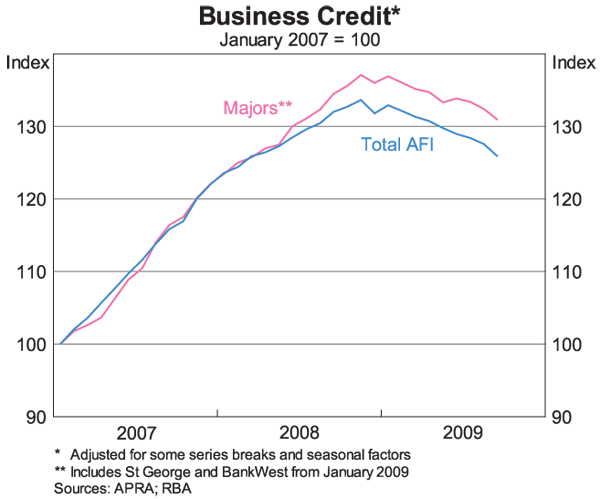
So when M&A activity and leveraged buyouts started to fade as the gap between the cost of equity and debt narrowed – so too did the underlying avenue of growth for the foreign banks. By mid 2009, syndicated loan approvals had fallen to around $10–15 billion a quarter, compared with around $40 billion a quarter over the first half of 2007 (Graph 9). While there are a few instances of foreign banks scaling back their operations in Australia, there is little evidence of any generalised withdrawal of foreign banks from the market. Foreign banks have continued to participate in recent syndicated loans, albeit at significantly lower volumes than in the M&A heyday.
Reflecting Australian corporates' recent focus on strengthening their balance sheets by repaying debt, about three-fifths of the syndicated loan approvals over the past year and a half have been used to refinance existing debt. There has been very little lending for acquisitions.
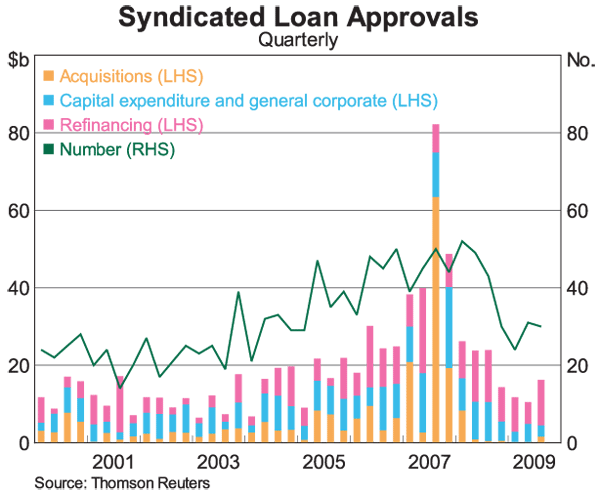
Conclusion
Let me summarise the main points of my talk:
- Leverage in the corporate sector has been declining, with intermediated debt being replaced by record raisings of equity.
- Over the past year or so, investor appetite for bonds has increased, leading to a wider range of corporates that have (re)entered this market.
- Banks have imposed tighter terms and conditions on their lending. These have acted as a significant constraint upon some corporates, especially real estate and infrastructure. For the most part, however, firms have been able to refinance as needed, and it has been firms' desire to reduce leverage against the background of an uncertain economic outlook that has lead to a reduction in the demand for credit.
Endnote
The discussion here draws heavily upon ‘Australian Corporates' Sources and Uses of Funding’,
RBA Bulletin October 2009. [1]